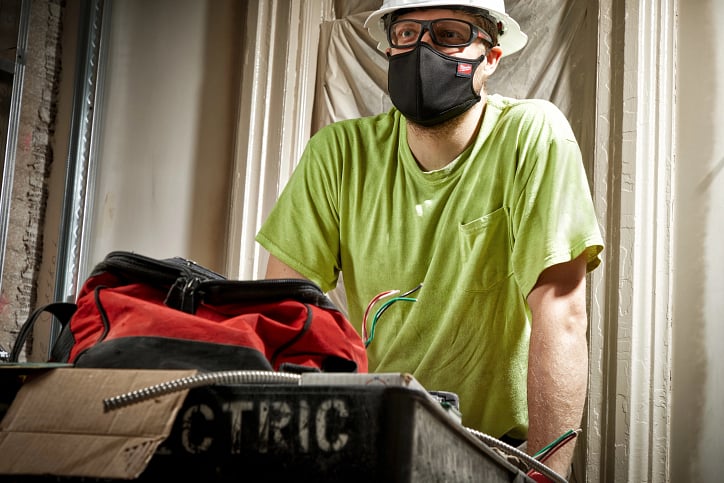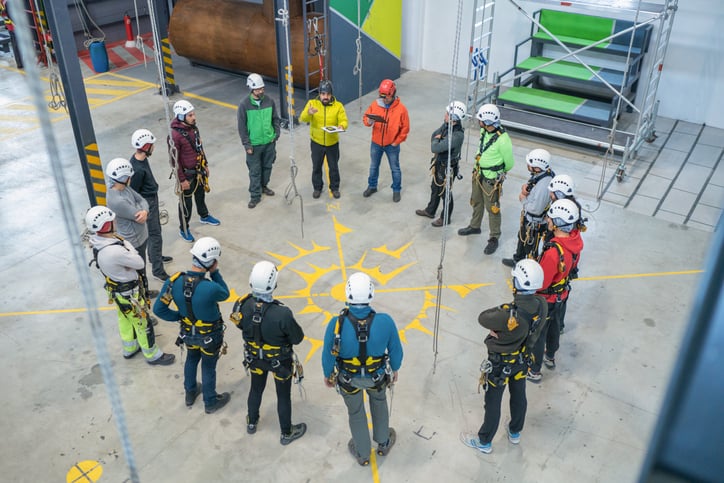 When it comes to hiring skilled trades, it’s become an applicant’s market. Skilled trades are in demand, with industry-wide labor shortages intensifying and a skills gap widening rapidly over the years. Since 2013, shortages for subcontractors and labor have been persistent, according to a report by the Home Builders Institute. Compounding, 63% of builders reported labor shortages in 2017, raising to 67% in 2018 (while the Associated General Contractors of America reported an even higher 80% that year), and 69% in 2019. Reported in a study by Angi (formerly, Angi’s List), in 2021, 77% of tradespeople viewed labor shortages for skilled trades a problem, up from 70% in 2020, while the U.S. Chamber of commerce reported 88% of contractors expressing moderate-to-high levels of difficulty finding skilled workers, and a 2021 report by the Associated General Contractors of America reported an even higher 89% of contractors struggling to fill craft positions in large part due to COVID-19 disruptions that are still affecting supply chains and representing 93% of project delays.
When it comes to hiring skilled trades, it’s become an applicant’s market. Skilled trades are in demand, with industry-wide labor shortages intensifying and a skills gap widening rapidly over the years. Since 2013, shortages for subcontractors and labor have been persistent, according to a report by the Home Builders Institute. Compounding, 63% of builders reported labor shortages in 2017, raising to 67% in 2018 (while the Associated General Contractors of America reported an even higher 80% that year), and 69% in 2019. Reported in a study by Angi (formerly, Angi’s List), in 2021, 77% of tradespeople viewed labor shortages for skilled trades a problem, up from 70% in 2020, while the U.S. Chamber of commerce reported 88% of contractors expressing moderate-to-high levels of difficulty finding skilled workers, and a 2021 report by the Associated General Contractors of America reported an even higher 89% of contractors struggling to fill craft positions in large part due to COVID-19 disruptions that are still affecting supply chains and representing 93% of project delays.
Despite the pandemic intensifying the shortage of skilled trades workers, as these statistics help illustrate, this problem has long plagued the industry at large.
In this article, we’d like to accomplish few things:
Why Is There a Labor Shortage in Construction?
There are many reasons for the shortage of skilled workers in the construction trades. 
For our purposes, we’ll discuss four, both current and ongoing:
- COVID-19-related industry disruptions
- Skilled trades aging out
- Fewer young people going into the trades due to an unfair stigma
- Lack of diversity and inclusion
Let’s dive into each of these a bit deeper.
#1 Skilled Labor Shortage Reason: COVID-19-related Industry Disruptions.
As reported in Construction Dive, the construction industry has had the highest rate of COVID-19 of nearly any other industry, a University of Texas study concluding that construction workers were 5 times more likely to be hospitalized with COVID-19 than in all other industries, including those who can work from home. While the industry was already facing significant difficulties filling craft positions, the pandemic has only intensified these skills gaps.

#2 Skilled Labor Shortage Reason: Trades Aging Out.
The median age of skilled trades is 43, roughly 10% older than the general population, as reported in the same study by Angi. Meanwhile, the average age of GCs is 47, 24% higher than the population. More than a quarter of tradespeople are within 10 years of the Social Security retirement age of 62.

#3 Skilled Labor Shortage Reason: An Unfair, Strange Stigma
As noted in the same Angi study above, since 1980, traditional college enrollments have increased by over 60%, leading to an unfair stigma surrounding the trades. What’s more, 54% of Americans overprioritize university at the expense of trade school, while 62% think there is a lack of respect for blue collar work.
The strange irony: Average student loan debt for traditional college graduates is $28,950 (or $71,000 for graduate school loan debt, $145,000 for law school debt, $201,490 for medical school debt), according to Nerd Wallet. Consider Glassdoor’s “20 most popular jobs for college graduates” and how the base pay averaged across these 20 jobs is a meager $45,888, a weak return on investment. Those who brave the additional student loan debt of a PhD program may net a higher average salary of $95,551 as an assistant professor, though many PhDs find actually themselves low-paid post-doc research positions. Considering that a PhD typically takes 6 years of study (following 4 years of college), the return on investment is far from immediate. Similarly, some entry-level attorneys make between $60k and $109k, a far cry from paying down those interest-accruing law school debts.

Meanwhile, those who enter the trades can expect an average salary across most traditional trades of $50k+ with less of an investment in training and time, ranging from on-the-job training and apprenticeships to some college through technical school or junior colleges. What’s more, tradespeople are far more satisfied with their jobs, with skilled trades reporting an 83% career satisfaction due to overall compensation and flexibility in work. Additional experience on the job and completion of a bachelor’s degree in construction management can result in a high-paying leadership role netting $90k+.
#4. Skilled Labor Shortage Reason: Lack of Diversity and Inclusion
Construction remains overwhelmingly white and male, 98% of electricians and plumbers, for example, male, while 97% of construction supervisors are male. What’s more, though Hispanic or Latino people represent 30% of construction workers, as Construction Dive points out, they’re often in lower-level positions without opportunities for advancement.

Additionally, 59% agree that providing a clear pathway for women would make the trades more welcoming.
How to Stay Competitive and Attract High-Skilled, Highly In-Demand Trades
Now, we all know the effects of skilled labor shortages firsthand. How do you combat them to attract in-demand trades and remain productive?
Here are 6 ways to attract in-demand skilled trades without hemorrhaging cash:
- Start at the apprenticeship
- Offer a holistic compensation package
- Offer training and safety programs
- Seek out interns and offer “returnships”
- Create opportunities for career development
- Foster diversity and inclusion
Again, let’s dive into each of these a bit deeper.
1. Start at the Apprenticeship
42% technical expertise of skilled trades is learned on the job. Hiring and training budding apprentices may seem like a lot of commitment up front, but it also helps keep them around. High-paid construction apprenticeships, relative to other entry-level work in other industries, can be very attractive to young people, and can be a smart move when you’ve got more experienced tradespeople nearing retirement age.

2. Offer a Holistic Compensation Package
Money isn’t everything, though bonuses for high performers or equity in the company can substitute a high gross pay and help your team feel valued and part of the company. Outside of monetary compensation, though, company culture is often in fact the key to attracting and retaining employees.
What’s more, simple things like offering team-building activities can go a long way to boosting team morale, whether that’s an after-hours happy hour at a craft brewery or putting a massage chair in the jobsite trailer. Playing board games or video games can help get the team in good spirits, but it can also serve as a good design and building inspiration to stimulate productivity gains on the job later. The ONE-KEY™ team here at Milwaukee® uses board games as an icebreaker in many of our in-person interviews to help identify good culture fits. Since the pandemic hit, we’ve also gravitated toward jackbox.tv to boost team morale.
3. Offer Safety and Training Programs
As the #1 most dangerous occupation, construction safety is a crucial consideration to keeping your people whole.

Providing safety and training programs organization-wide assures the team you care about their wellbeing. What might this look like? You might:
- Hire a dedicated safety manager to develop company-wide safety programs.
- Invest in smart tools with integrated features to make usage more precise, while reducing repetitive motion injuries.
- Pilot construction drones to perform safety inspections remotely.
- Invest in PPE for your team so they don’t have to purchase their own.
4. Seek Out Interns and Offer “Returnships”
Similar to apprenticeships, hiring interns, either in-office or in-field, can be beneficial for both your company and the intern—you get access to relatively inexpensive labor, while they get access to invaluable real-world experience.

Potential interns could be those enrolled in a technical college or community college, or a traditional 4-year university. For example, interns enrolled in bachelor’s degrees in areas of studies like architecture, civil engineering, or landscape architecture can shadow experienced construction project managers, designers, BIM specialists, tradespeople, landscapers, construction technologists, and the like.
Another consideration is offering opportunities for a “returnship": A returnship is a sort of internship for experienced workers, those who have taken extended time off, to get back into the workforce.
5. Create Opportunities for Career Development
Maybe you’ve hired a minted trade fresh off his or her apprenticeship, or maybe you’ve promoted your intern. Creating a clear pathway for advancement is key to retaining the skilled talent you’ve developed.

6. Foster Diversity and Inclusion
McKinsey’s “delivering through diversity” study found that companies in the top-quartile for gender diversity on their executive teams were 21% more likely to have above-average profitability, while executive teams with ethnic/cultural diversity were 33% more likely to outperform on profitability.

How do we get there? Bridging the construction diversity gap starts with:
- Create gender-neutral job postings – one way to attract a wider talent pool from the job posting and move in a more inclusive direction is using gender-neutral pronouns and avoiding gendered verbiage.
- Overcome language barriers – employees should accommodate people from diverse backgrounds and offering a language training program for employees not fluent in English would be a good start. Visual aids may be used when communicating safety procedures.
- Support open communication – You should encourage open communication and allow minorities to share their stories by creating an environment where employees feel comfortable speaking up.
What Can We Do as an Industry to Close the Skilled Trades Gap and Attract Talent?
So, we’ve got some strategies to attract skilled trades. But what can we do as an industry to close the skilled trades gap and attract new talent?
It starts with undoing the unfair stigma associated with going into the trades.
This may involve partnering with area high schools early to educate and build awareness about the value of the trades and dismantle their associated myths. For example, an educational info session may include talking points like:
- the excellent ROI an apprenticeship may offer immediately
- high-skilled trades are in high-demand, while traditional college grads fight over fewer jobs with lower starting pay
- how a tradesperson’s career opportunities quantify with experience
College graduates who are unsatisfied with their career prospects may also consider a second career in the trades.
Bottom line: Are skilled trades in demand? Absolutely. With a skilled trades gap driven by an aging workforce, decades’ worth of an unfair stigma surrounding the trades, and a global pandemic that is still worsening, effects of skilled labor shortage are likely to continue. But attracting talent starts with building a company culture that is inclusive and creating opportunities for advancement that will make skilled trades want to jump in line.